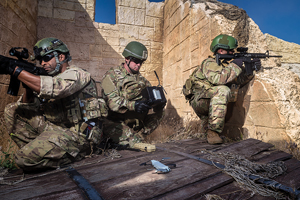U.S. military recruits might soon be issued something a bit more high tech than the standard uniform, boots, and rifle.
An undisclosed branch of the military took delivery in April of 20 Snipe drones manufactured by AeroVironment Inc. of Monrovia. Unlike previous drones used by the military, which require specially trained pilots, the Snipe is designed to be flown by novice soldiers on scouting missions.
“The vast majority of troops don’t have access to an unmanned aircraft system,” said Steve Gitlin, AeroVironment’s vice president of investor relations. “The idea of the Snipe is that it is small enough and light enough that it could fit in the pocket of an individual.”
Such pocket-size features could create enormous demand for the product if a military branch opted to distribute Snipe drones to each infantry squad – or even as standard-issue equipment.
“That would mean demand for thousands of units assuming they market globally, which they will,” said Mike Blades, a senior industry analyst in San Antonio with Frost & Sullivan. “I seriously doubt a unit would only have one – you always need a spare.”
Gitlin declined to disclose the price of the Snipe, but he said the company plans to focus its attention on selling to the U.S. military and its allies, possibly selling to police and fire departments, and agencies that perform search and rescue.
“The more troops our customers designate to be equipped with a nano drone, the larger the unit sale opportunity,” he said in an email, adding that the price point of a drone such as the Snipe would be lower than that of its Raven, Puma AE and Wasp AE systems. He cited a Defense Department report that said those drones comprise more than 85 percent of the Pentagon’s drone fleet.
“We are planning on introducing an exportable version of it for allied forces,” he said. “We’ve already received inquiries about it from international customers.”
U.S. military branches are already experimenting with small drones, including the Marine Corps, which this year started giving some infantry units the PD-100 Black Hornet, a humming bird-size drone equipped with a color camera that reportedly costs more than $50,000 and is manufactured by Norway’s Prox Dynamics.
The Marines aim to give troops an information advantage over enemy forces, said Lt. Col. Eric Dent, a public affairs officer for the Marines.
“We want small drones available to every infantry squad so that we can give them eyes and ears on what’s just over the ridge, on the roof of an adjacent building, etc.,” he wrote in an email. “To put it bluntly, we aren’t looking for a fair fight.”
The Snipe isn’t a toy, but you could be excused for thinking it was.
The palm-size drone weighs less than 5 ounces and is the smallest such vehicle AeroVironment has ever sold, according to Gitlin. It is capable of maintaining flight in wind gusts up to 20 miles per hour and in temperatures ranging from -25 degrees to 120 degrees.
It looks much like hobbyist drones on the market, featuring a quadcopter design, folding rotor arms, and a touch-screen flight controller. Those easy-to-use features have allowed novice consumers to fly similar-looking aircraft such as the Mavic quadcopter, manufactured by Dà-Jiāng Innovations Science and Technology Co. of Shenzhen, China.
Flying the Snipe requires only a couple of hours of training. That’s compared with the roughly two weeks needed to learn how to pilot AeroVironment’s previous Raven, Puma, or Wasp drones, Gitlin said.
Yet the Snipe is a much more sophisticated tool.
“They may look similar, but a lot of the technology we employ is quite different in terms of encryption, stabilization, and the fact that the Snipe has two sensors on it,” a color video sensor and infrared sensor, he explained. “The drones have to be able to withstand tough landings and hard landings. That can’t be said for a lot of the toys that are out there today.”
AeroVironment claims the drones, which come preassembled, can be taken out of a soldier’s pocket and launched in less than 60 seconds. The Snipe has a battery life of 15 minutes, which gives the drone a range of 1,000 meters, enough to peer over a wall, down an alley, or around a hill, the firm said.
Soaring market
The market for small drones such as the Snipe and Black Hornet has not yet been determined, industry experts said, because military leaders are still evaluating the aircraft’s potential.
The U.S. military has nonetheless proved to be a hungry customer for drone technology, spending $4.5 billion on drones of all sizes in 2014, with projections of $6.25 billion in spending by 2021, according to Blades of Frost & Sullivan. AeroVironment has benefited enormously from that appetite. The company’s products account for more than 85 percent of drones sold to the U.S. military, including more than 19,000 of its Raven surveillance drones since the product’s launch in 2003. The company generated more than $264 million in revenue in fiscal 2016, with a net income of about $9 million.
Though some Chinese-manufactured drones have similar performance capabilities, AeroVironment won’t have to compete against those products when selling to the military, said Patrick Egan, editor of online drone industry publication Suas News.
“There are more and more concerns with what data the Chinese are collecting,” he said. “In a lot of circles, anything made in China is suspect in terms of espionage.”
Other U.S. drone makers have also failed to develop any substantial foothold in the military sector, Egan noted.
“There are almost no American companies building drones now, because you can’t compete,” he said. “Even if AeroVironment is charging $40,000 for this, (the military is) over a barrel because there is no competition.”

